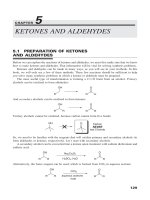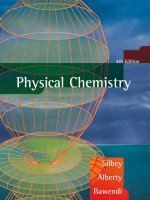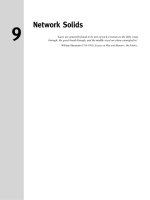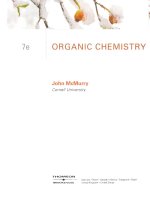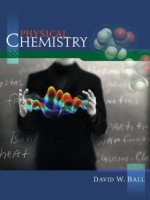Ebook General chemistry The essential concepts Part 1
Bạn đang xem bản rút gọn của tài liệu. Xem và tải ngay bản đầy đủ của tài liệu tại đây (2.84 MB, 20 trang )
cha75632_fm_i-xxii.indd Page i
11/3/09
8:11:51 PM user-s180
/Volumes/MHDQ-New/MHDQ144/MHDQ144-FM
General Chemistry
cha75632_fm_i-xxii.indd Page ii
11/4/09
2:18:43 PM user-s180
About the Cover
The cover shows a diatomic molecule being irradiated with
laser light of appropriate frequency. As a result, the molecule
is promoted to a highly excited vibrational energy level,
which subsequently leads to dissociation into atomic
species.
/Volumes/MHDQ-New/MHDQ144/MHDQ144-FM
cha75632_fm_i-xxii.indd Page iii
11/3/09
8:11:52 PM user-s180
/Volumes/MHDQ-New/MHDQ144/MHDQ144-FM
General Chemistry
The Essential Concepts
Sixth Edition
Raymond Chang
Williams College
Jason Overby
The College of Charleston
TM
cha75632_fm_i-xxii.indd Page iv
11/3/09
8:11:53 PM user-s180
/Volumes/MHDQ-New/MHDQ144/MHDQ144-FM
TM
GENERAL CHEMISTRY: THE ESSENTIAL CONCEPTS, SIXTH EDITION
Published by McGraw-Hill, a business unit of The McGraw-Hill Companies, Inc., 1221 Avenue of the Americas,
New York, NY 10020. Copyright © 2011 by The McGraw-Hill Companies, Inc. All rights reserved. Previous editions
© 2008, 2006, and 2003. No part of this publication may be reproduced or distributed in any form or by any means, or
stored in a database or retrieval system, without the prior written consent of The McGraw-Hill Companies, Inc., including,
but not limited to, in any network or other electronic storage or transmission, or broadcast for distance learning.
Some ancillaries, including electronic and print components, may not be available to customers outside the United States.
This book is printed on acid-free paper.
1 2 3 4 5 6 7 8 9 0 DOW/DOW 1 0 9 8 7 6 5 4 3 2 1 0
ISBN 978–0–07–337563–2
MHID 0–07–337563–2
Publisher: Ryan Blankenship
Senior Sponsoring Editor: Tamara L. Hodge
Director of Development: Kristine Tibbetts
Senior Developmental Editor: Shirley R. Oberbroeckling
Senior Marketing Manager: Todd L. Turner
Senior Project Manager: Gloria G. Schiesl
Senior Production Supervisor: Kara Kudronowicz
Lead Media Project Manager: Judi David
Senior Designer: Laurie B. Janssen
Cover Illustration: Precision Graphics
Senior Photo Research Coordinator: John C. Leland
Photo Research: Toni Michaels/PhotoFind, LLC
Supplement Producer: Mary Jane Lampe
Compositor: Aptara, Inc.
Typeface: 10/12 Times Roman
Printer: R. R. Donnelley
All credits appearing on page or at the end of the book are considered to be an extension of the copyright page.
Library of Congress Cataloging-in-Publication Data
Chang, Raymond.
General chemistry : the essential concepts / Raymond Chang. — 6th ed. / Jason Overby.
p. cm.
Includes index.
ISBN 978–0–07–337563–2 — ISBN 0–07–337563–2 (hard copy : alk. paper) 1. Chemistry—Textbooks. I. Overby,
Jason Scott, 1970- II. Title.
QD33.2.C48 2011
540—dc22
2009034749
www.mhhe.com
cha75632_fm_i-xxii.indd Page v
11/3/09
8:11:53 PM user-s180
ABOUT
/Volumes/MHDQ-New/MHDQ144/MHDQ144-FM
THE
AUTHORS
Raymond Chang was born in Hong Kong and grew up in Shanghai and Hong
Kong. He received his B.Sc. degree in chemistry from London University, England,
and his Ph.D. in chemistry from Yale University. After doing postdoctoral research at
Washington University and teaching for a year at Hunter College of the City University of New York, he joined the chemistry department at Williams College, where he
has taught since 1968.
Professor Chang has served on the American Chemical Society Examination
Committee, the National Chemistry Olympiad Examination Committee, and the
Graduate Record Examinations (GRE) Committee. He is an editor of The Chemical
Educator. Professor Chang has written books on physical chemistry, industrial chemistry,
and physical science. He has also coauthored books on the Chinese language, children’s
picture books, and a novel for young readers.
For relaxation, Professor Chang maintains a forest garden; plays tennis, PingPong, and the harmonica; and practices the violin.
Jason Overby was born in Bowling Green, Kentucky, and grew up in Clarksville,
Tennessee. He received his B.S. in chemistry and political science from the University
of Tennessee at Martin and his Ph.D. in inorganic chemistry from Vanderbilt University.
After postdoctoral research at Dartmouth College, he began his academic career at
the College of Charleston in 1999.
Professor Overby maintains research interests in synthetic and computational
inorganic and organometallic chemistry. His educational pursuits include inorganic
chemistry laboratory pedagogy and the use of digital technology, including online
homework,
h
as tools in the classroom.
In his spare time, Professor Overby enjoys cooking, computers, and spending
time with his family.
v
cha75632_fm_i-xxii.indd Page vi
11/3/09
8:11:55 PM user-s180
BRIEF CONTENTS
1
2
3
4
5
6
7
8
9
10
11
12
13
14
15
16
17
18
19
20
21
22
Appendix
Appendix
Appendix
Appendix
vi
Introduction 1
Atoms, Molecules, and Ions 29
Stoichiometry 60
Reactions in Aqueous Solutions 97
Gases 136
Energy Relationships in Chemical Reactions 176
The Electronic Structure of Atoms 211
The Periodic Table 251
Chemical Bonding I: The Covalent Bond 285
Chemical Bonding II: Molecular Geometry and
Hybridization of Atomic Orbitals 320
Introduction to Organic Chemistry 363
Intermolecular Forces and Liquids and Solids 399
Physical Properties of Solutions 436
Chemical Kinetics 466
Chemical Equilibrium 510
Acids and Bases 544
Acid-Base Equilibria and Solubility Equilibria 590
Thermodynamics 628
Redox Reactions and Electrochemistry 661
The Chemistry of Coordination Compounds 703
Nuclear Chemistry 728
Organic Polymers—Synthetic and Natural 761
Units for the Gas Constant A-1
Selected Thermodynamic Data at 1 atm and 25°C A-2
Mathematical Operations A-6
The Elements and the Derivation of Their Names and
Symbols A-9
/Volumes/MHDQ-New/MHDQ144/MHDQ144-FM
cha75632_fm_i-xxii.indd Page vii
11/3/09
8:11:56 PM user-s180
/Volumes/MHDQ-New/MHDQ144/MHDQ144-FM
CONTENTS
List of Animations xiv
Preface xv
A Note to the Student xxii
CHA P TE R
1
Introduction 1
1.1
1.2
1.3
1.4
1.5
1.6
1.7
The Study of Chemistry 2
The Scientific Method 2
Classifications of Matter 4
Physical and Chemical Properties of Matter 7
Measurement 8
Handling Numbers 13
Dimensional Analysis in Solving Problems 18
Key Equations 22
Summary of Facts and Concepts
Key Words 23
Questions and Problems 23
CHA P TE R
2
Atoms, Molecules, and Ions 29
2.1
2.2
2.3
2.4
2.5
2.6
2.7
2.8
The Atomic Theory 30
The Structure of the Atom 31
Atomic Number, Mass Number, and Isotopes
The Periodic Table 38
Molecules and Ions 39
Chemical Formulas 41
Naming Compounds 44
Introduction to Organic Compounds 52
Summary of Facts and Concepts
Key Words 54
Questions and Problems 54
CHA P TE R
3
22
36
53
Stoichiometry 60
3.1
3.2
3.3
3.4
3.5
3.6
3.7
3.8
3.9
Atomic Mass 61
Avogadro’s Number and the Molar Mass of an Element 62
Molecular Mass 66
The Mass Spectrometer 68
Percent Composition of Compounds 70
Experimental Determination of Empirical Formulas 72
Chemical Reactions and Chemical Equations 75
Amounts of Reactants and Products 79
Limiting Reagents 83
vii
cha75632_fm_i-xxii.indd Page viii
viii
11/3/09
8:11:59 PM user-s180
/Volumes/MHDQ-New/MHDQ144/MHDQ144-FM
Contents
3.10 Reaction Yield 86
Key Equations 88
Summary of Facts and Concepts
Key Words 88
Questions and Problems 88
CHA P TE R
4
Reactions in Aqueous Solutions
4.1
4.2
4.3
4.4
4.5
4.6
5
Gases
5.1
5.2
5.3
5.4
5.5
5.6
5.7
6
98
128
136
Substances That Exist as Gases 137
Pressure of a Gas 138
The Gas Laws 141
The Ideal Gas Equation 146
Dalton’s Law of Partial Pressures 152
The Kinetic Molecular Theory of Gases 157
Deviation from Ideal Behavior 164
Key Equations 166
Summary of Facts and Concepts
Key Words 168
Questions and Problems 168
CHA P TE R
97
General Properties of Aqueous Solutions
Precipitation Reactions 100
Acid-Base Reactions 105
Oxidation-Reduction Reactions 109
Concentration of Solutions 118
Solution Stoichiometry 122
Key Equations 128
Summary of Facts and Concepts
Key Words 128
Questions and Problems 129
CHA P TE R
88
167
Energy Relationships in Chemical
Reactions 176
6.1
6.2
6.3
6.4
6.5
6.6
The Nature of Energy and Types
of Energy 177
Energy Changes in Chemical Reactions
Introduction to Thermodynamics 179
Enthalpy of Chemical Reactions 185
Calorimetry 191
Standard Enthalpy of Formation
and Reaction 196
Key Equations 202
Summary of Facts and Concepts
Key Words 202
Questions and Problems 203
202
178
cha75632_fm_i-xxii.indd Page ix
11/3/09
8:12:00 PM user-s180
/Volumes/MHDQ-New/MHDQ144/MHDQ144-FM
Contents
CHA P TE R
7
The Electronic Structure
of Atoms 211
7.1
7.2
7.3
7.4
7.5
7.6
7.7
7.8
7.9
From Classical Physics to Quantum Theory 212
The Photoelectric Effect 216
Bohr’s Theory of the Hydrogen Atom 218
The Dual Nature of the Electron 222
Quantum Mechanics 225
Quantum Numbers 226
Atomic Orbitals 228
Electron Configuration 232
The Building-Up Principle 239
Key Equations 242
Summary of Facts and Concepts
Key Words 243
Questions and Problems 244
CHA P TE R
8
The Periodic Table 251
8.1
8.2
8.3
8.4
8.5
8.6
Development of the Periodic Table 252
Periodic Classification of the Elements 253
Periodic Variation in Physical Properties 256
Ionization Energy 262
Electron Affinity 266
Variation in Chemical Properties of the Representative
Elements 268
Key Equation 278
Summary of Facts and Concepts
Key Words 279
Questions and Problems 279
CHA P TE R
9
243
278
Chemical Bonding I: The
Covalent Bond 285
9.1
9.2
9.3
9.4
9.5
9.6
9.7
9.8
9.9
9.10
Lewis Dot Symbols 286
The Ionic Bond 287
Lattice Energy of Ionic Compounds 289
The Covalent Bond 291
Electronegativity 293
Writing Lewis Structures 297
Formal Charge and Lewis Structure 300
The Concept of Resonance 303
Exceptions to the Octet Rule 305
Bond Enthalpy 309
Key Equation 313
Summary of Facts and Concepts 313
Key Words 313
Questions and Problems 314
ix
cha75632_fm_i-xxii.indd Page x 11/19/09 5:04:10 PM user-s180
x
/Volumes/MHDQ-New/MHDQ144/MHDQ144-FM
Contents
CHA P TE R
10
Chemical Bonding II: Molecular Geometry
and Hybridization of Atomic Orbitals 320
10.1
10.2
10.3
10.4
10.5
10.6
Molecular Geometry 321
Dipole Moments 331
Valence Bond Theory 334
Hybridization of Atomic Orbitals 336
Hybridization in Molecules Containing Double and
Triple Bonds 345
Molecular Orbital Theory 348
Key Equations 357
Summary of Facts and Concepts 357
Key Words 358
Questions and Problems 358
CHA P TE R
11
Introduction to Organic Chemistry 363
11.1
11.2
11.3
11.4
11.5
Classes of Organic Compounds 364
Aliphatic Hydrocarbons 364
Aromatic Hydrocarbons 379
Chemistry of the Functional Groups 382
Chirality—The Handedness of Molecules 389
O
Summary of Facts and Concepts 393
Key Words 393
Questions and Problems 393
CHA P TE R
12
The Kinetic Molecular Theory of Liquids and Solids 400
Intermolecular Forces 401
Properties of Liquids 407
Crystal Structure 410
Bonding in Solids 416
Phase Changes 419
Phase Diagrams 427
Key Equations 428
Summary of Facts and Concepts
Key Words 429
Questions and Problems 429
CHA P TE R
13
CH 3
Intermolecular Forces and Liquids and Solids 399
12.1
12.2
12.3
12.4
12.5
12.6
12.7
428
Physical Properties of Solutions
13.1
13.2
13.3
13.4
13.5
13.6
HO
436
Types of Solutions 437
A Molecular View of the Solution Process 437
Concentration Units 440
Effect of Temperature on Solubility 443
Effect of Pressure on the Solubility of Gases 445
Colligative Properties 447
H
N
O
cha75632_fm_i-xxii.indd Page xi 11/19/09 5:04:32 PM user-s180
/Volumes/MHDQ-New/MHDQ144/MHDQ144-FM
Contents
Key Equations 458
Summary of Facts and Concepts
Key Words 459
Questions and Problems 459
CHA P TE R
14
Chemical Kinetics
14.1
14.2
14.3
14.4
14.5
14.6
466
The Rate of a Reaction 467
The Rate Laws 471
Relation Between Reactant Concentrations
and Time 475
Activation Energy and Temperature Dependence
of Rate Constants 483
Reaction Mechanisms 489
Catalysis 493
Key Equations 499
Summary of Facts and Concepts
Key Words 500
Questions and Problems 500
CHA P TE R
15
Chemical Equilibrium
15.1
15.2
15.3
15.4
16
499
510
The Concept of Equilibrium 511
Ways of Expressing Equilibrium Constants 514
What Does the Equilibrium Constant Tell Us? 521
Factors That Affect Chemical Equilibrium 526
Key Equations 534
Summary of Facts and Concepts
Key Words 534
Questions and Problems 534
CHA P TE R
459
Acids and Bases
534
544
16.1
16.2
16.3
16.4
16.5
16.6
16.7
Brønsted Acids and Bases 545
The Acid-Base Properties of Water 546
pH—A Measure of Acidity 548
Strength of Acids and Bases 551
Weak Acids and Acid Ionization Constants 555
Weak Bases and Base Ionization Constants 566
The Relationship Between Conjugate Acid-Base
Ionization Constants 569
16.8 Molecular Structure and the Strength of Acids 570
16.9 Acid-Base Properties of Salts 573
16.10 Acidic, Basic, and Amphoteric Oxides 579
16.11 Lewis Acids and Bases 581
Key Equations 583
Summary of Facts and Concepts
Key Words 583
Questions and Problems 584
583
xi
cha75632_fm_i-xxii.indd Page xii
xii
11/3/09
8:12:08 PM user-s180
Contents
CHA P TE R
17
Acid-Base Equilibria and
Solubility Equilibria 590
17.1
17.2
17.3
17.4
17.5
17.6
17.7
17.8
Homogeneous Versus Heterogeneous Solution
Equilibria 591
Buffer Solutions 591
A Closer Look at Acid-Base Titrations 597
Acid-Base Indicators 603
Solubility Equilibria 606
The Common Ion Effect and Solubility 613
Complex Ion Equilibria and Solubility 614
Application of the Solubility Product Principle
to Qualitative Analysis 617
Key Equations 620
Summary of Facts and Concepts
Key Words 621
Questions and Problems 621
CHA P TE R
18
CHA P TE R
620
Thermodynamics 628
18.1
18.2
18.3
18.4
18.5
18.6
18.7
The Three Laws of Thermodynamics 629
Spontaneous Processes 629
Entropy 630
The Second Law of Thermodynamics 635
Gibbs Free Energy 641
Free Energy and Chemical Equilibrium 647
Thermodynamics in Living Systems 651
Key Equations 653
Summary of Facts and Concepts
Key Words 654
Questions and Problems 654
19
/Volumes/MHDQ-New/MHDQ144/MHDQ144-FM
653
Redox Reactions and Electrochemistry
19.1
19.2
19.3
19.4
19.5
19.6
19.7
19.8
19.9
Redox Reactions 662
Galvanic Cells 665
Standard Reduction Potentials 667
Thermodynamics of Redox Reactions 673
The Effect of Concentration on Cell Emf 676
Batteries 680
Corrosion 685
Electrolysis 687
Electrometallurgy 693
Key Equations 694
Summary of Facts and Concepts
Key Words 695
Questions and Problems 695
694
661
cha75632_fm_i-xxii.indd Page xiii
11/3/09
8:12:11 PM user-s180
/Volumes/MHDQ-New/MHDQ144/MHDQ144-FM
Contents
C H A P T E R
20
The Chemistry of Coordination Compounds 7033
20.1
20.2
20.3
20.4
20.5
20.6
Properties of the Transition Metals 704
Coordination Compounds 707
Geometry of Coordination Compounds 713
Bonding in Coordination Compounds: Crystal Field
Theory 715
Reactions of Coordination Compounds 721
Coordination Compounds in Living Systems 721
Key Equation 723
Summary of Facts and Concepts
Key Words 723
Questions and Problems 724
CHA P TE R
21
Nuclear Chemistry
21.1
21.2
21.3
21.4
21.5
21.6
21.7
21.8
728
The Nature of Nuclear Reactions 729
Nuclear Stability 731
Natural Radioactivity 736
Nuclear Transmutation 740
Nuclear Fission 743
Nuclear Fusion 748
Uses of Isotopes 750
Biological Effects of Radiation 753
Key Equations 754
Summary of Facts and Concepts
Key Words 755
Questions and Problems 755
CHA P TE R
22
723
754
Organic Polymers—Synthetic and Natural
22.1
22.2
22.3
22.4
761
Properties of Polymers 762
Synthetic Organic Polymers 762
Proteins 767
Nucleic Acids 774
Summary of Facts and Concepts
Key Words 777
Questions and Problems 777
776
Appendix 1 Units for the Gas Constant A-1
Appendix 2 Selected Thermodynamic Data at 1 atm and 25°C A-2
Appendix 3 Mathematical Operations A-6
Appendix 4 The Elements and the Derivation of Their Names and
Symbols A-9
Glossary G-1
Answers to Even-Numbered Problems AP-1
Credits C-1
Index I-1
xiii
cha75632_fm_i-xxii.indd Page xiv
LIST
OF
11/3/09
8:12:13 PM user-s180
/Volumes/MHDQ-New/MHDQ144/MHDQ144-FM
ANIMATIONS
The animations listed below are correlated to General Chemistry within each chapter in two ways. The first
is the Student Interactive Activities found in the opening pages of every chapter. Then within the chapter
are icons letting the student and the instructor know that an animation is available for a specific topic and
where to find the animation for viewing on our Chang General Chemistry ARIS website.
Chang Animations
Absorption of color (20.4)
Acid-base titrations (17.3)
Acid ionization (16.5)
Activation energy (14.4)
Alpha, beta, and gamma rays (2.2)
Alpha-particle scattering (2.2)
Atomic and ionic radius (8.3)
Base ionization (16.6)
Buffer solutions (17.2)
Catalysis (14.6)
Cathode ray tube (2.2)
Chemical equilibrium (15.1)
Chirality (11.5)
Collecting a gas over water (5.5)
Diffusion of gases (5.6)
Dissolution of an ionic and a covalent compound (13.2)
Electron configurations (7.8)
Emission spectra (7.3)
Equilibrium vapor pressure (12.6)
Formal charge calculations (9.7)
Galvanic cells (19.2)
Gas laws (5.3)
Heat flow (6.4)
Hybridization (10.4)
Hydration (4.1)
Ionic versus covalent bonding (9.4)
Le Châtelier’s principle (15.4)
Limiting reagent (3.9)
Making a solution (4.5)
Millikan oil drop (2.2)
Neutralization reactions (4.3)
Nuclear fission (21.5)
Orientation of collision (14.4)
Osmosis (13.6)
Oxidation-reduction reactions (4.4)
Packing spheres (12.4)
Polarity of molecules (10.2)
Precipitation reactions (4.2)
Preparing a solution by dilution (4.5)
xiv
Radioactive decay (21.3)
Resonance (9.8)
Sigma and pi bonds (10.5)
Strong electrolytes, weak electrolytes, and
nonelectrolytes (4.1)
VSEPR (10.1)
McGraw-Hill Animations
Atomic line spectra (7.3)
Charles’ law (5.3)
Cubic unit cells and their origins (12.4)
Dissociation of strong and weak acids (16.5)
Dissolving table salt (4.1)
Electronegativity (9.3)
Equilibrium (15.1)
Exothermic and endothermic reactions (6.2)
Formal charge calculations (9.5)
Formation of an ionic compound (9.3)
Formation of the covalent bond in H2 (10.4)
Half-life (14.3)
Influence of shape on polarity (10.2)
Law of conservation of mass (2.1)
Molecular shape and orbital hybridization (10.4)
Nuclear medicine (21.7)
Operation of voltaic cell (19.2)
Oxidation-reduction reaction (4.4 & 19.1)
Phase diagrams and the states of matter (12.7)
Reaction rate and the nature of collisions (14.4)
Three states of matter (1.3)
Using a buffer (17.2)
VSEPR theory and the shapes of molecules (10.1)
Simulations
Stoichiometry (Chapter 3)
Ideal gas law (Chapter 5)
Kinetics (Chapter 14)
Equilibrium (Chapter 15)
Titration (Chapter 17)
Electrochemistry (Chapter 19)
Nuclear (Chapter 21)
cha75632_fm_i-xxii.indd Page xv
11/3/09
8:12:14 PM user-s180
/Volumes/MHDQ-New/MHDQ144/MHDQ144-FM
PREFACE
The sixth edition of General Chemistry: The Essential
Concepts, continues the tradition of presenting only the
material that is essential to a one-year general chemistry
course. As with previous editions, it includes all the core
topics that are necessary for a solid foundation in general
chemistry without sacrificing depth, clarity, or rigor.
General Chemistry covers these topics in the same depth
and at the same level as 1100-page texts. All essential topics
are in the text with the exception of descriptive chemistry.
Therefore, this book is not a condensed version of a big text.
Our hope is that this concise-but-thorough approach will
appeal to efficiency-minded instructors and will please
value-conscious students. The positive feedback from users
over the years shows that there is a strong need for such a
text. So we have written a text containing all of the core concepts necessary for a solid foundation in general chemistry.
8:05:35 PM user-s180
• NEW to the chapters is the Review of Concepts feature. This is a quick knowledge test for the student to
gauge his or her understanding of the concept just
presented. The answers to the Review of Concepts
are available in the Student Solutions Manual and on
the companion ARIS (Assessment, Review, and
Instruction System) website.
R EVIEW OF CONCEPTS
Match each of the diagrams shown here with the following ionic compounds:
Al2O3, LiH, Na2S, Mg(NO3)2. (Green spheres represent cations and red spheres
represent anions.)
(a)
(b)
(c)
(d)
• NEW are powerful connections to electronic homework. All of the practice exercises for the Worked
Examples in all chapters are now found within the
What’s New in This Edition?
McGraw-Hill ARIS (Assessment, Review, and In• The most obvious change /Users/user-s180/Desktop/part
is the addition of a coau1 struction
upload System) electronic homework system. Each
thor, Jason Overby, who brings new pedagogical inend-of-chapter problem in ARIS is noted in the Elecsights to the text.
tronic Homework Problem section by an icon.
3.110 Cysteine, shown here, is one of the 20 amino acids
found in proteins in humans. Write the molecular
formula and calculate its percent composition by
mass.
H
S
O
C
Problem in Text
Problem in ARIS
xv
cha75632_fm_i-xxii.indd Page xvi
xvi
11/3/09
8:12:17 PM user-s180
/Volumes/MHDQ-New/MHDQ144/MHDQ144-FM
Preface
• Many sections have been revised and updated based
on the comments from reviewers and users. Some
examples are
—A revised treatment of amounts of reactants and
products is given in Chapter 3.
—A revised explanation of thermochemical equations
is presented in Chapter 6.
cha75632_ch03_060-096.indd Page 82
—Expanded coverage of effective
nuclear charge
appears in Chapter 8.
—New computer-generated molecular orbital diagrams are presented in Chapter 10.
—Many new end-of-chapter problems with molecular art have been added to test the conceptual comprehension and critical thinking skills of the
student. The more challenging problems are added
to the Special Problems section.
—A revised discussion of the frequency factor in the
Arrhenius equation is given in Chapter 14.
—The ARIS electronic homework system is available for the sixth edition. ARIS will enhance the
student learning experience, administer assignments, track student progress, and administer an
instructor’s course. The students can locate the
animations and interactives noted in the text margins in ARIS. Quizzing and homework assigned
by the instructor is available in the ARIS electronic
homework program.
• Check enables the student to compare and verify
with the source information to make sure that the
answer is reasonable.
• Practice Exercise provides the opportunity to solve a
similar problem in order to become proficient in this
problem type. The Practice Exercises are available in
the ARIS electronic homework system. The marginal
note lists additional similar problems to work in the
problem section.
8/13/09end-of-chapter
8:04:45 PM user-s180
/Users/user-s180/Desktop/part 1 upload
EXAMPLE 3.13
The food we eat is degraded, or broken down, in our bodies to provide energy for growth
and function. A general overall equation for this very complex process represents the
degradation of glucose (C6H12O6) to carbon dioxide (CO2) and water (H2O):
C6H12O6 1 6O2 ¡ 6CO2 1 6H2O
If 968 g of C6H12O6 is consumed by a person over a certain period, what is the mass of
CO2 produced?
Strategy Looking at the balanced equation, how do we compare the amount of
C6H12O6 and CO2? We can compare them based on the mole ratio from the balanced
equation. Starting with grams of C6H12O6, how do we convert to moles of C6H12O6?
Once moles of CO2 are determined using the mole ratio from the balanced equation,
how do we convert to grams of CO2?
Solution We follow the preceding steps and Figure 3.8.
Step 1: The balanced equation is given in the problem.
Step 2: To convert grams of C6H12O6 to moles of C6H12O6, we write
968 g C6H12O6 3
1 mol C6H12O6
5 5.372 mol C6H12O6
180.2 g C6H12O6
Step 3: From the mole ratio, we see that 1 mol C6H12O6 ∞ 6 mol CO2. Therefore, the
number of moles of CO2 formed is
5.372 mol C6H12O6 3
6 mol CO2
5 32.23 mol CO2
1 mol C6H12O6
Step 4: Finally, the number of grams of CO2 formed is given by
32.23 mol CO2 3
44.01 g CO2
5 1.42 3 103 g CO2
1 mol CO2
After some practice, we can combine the conversion steps
grams of C6H12O6 ¡ moles of C6H12O6 ¡ moles of CO2 ¡ grams of CO2
into one equation:
Problem Solving
The development of problem-solving skills has always been
a major objective of this text. The two major categories of
learning are the worked examples and end-of-chapter
problems. Many of them present extra tidbits of knowledge
and enable the student to solve a problem that a chemist
would solve. The examples and problems show students the
real world of chemistry and applications to everyday life
situations.
Worked examples follow a proven step-by-step strategy and solution.
• Problem statement is the reporting of the facts needed
to solve the problem based on the question posed.
• Strategy is a carefully thought-out plan or method to
serve as an important function of learning. In some
cases, students are shown a rough sketch, which helps
them visualize the physical setup.
• Solution is the process of solving a problem given in
a stepwise manner.
mass of CO2 5 968 g C6H12O6 3
44.01 g CO2
1 mol C6H12O6
6 mol CO2
3
3
180.2 g C6H12O6
1 mol C6H12O6
1 mol CO2
5 1.42 3 103 g CO2
Check Does the answer seem reasonable? Should the mass of CO2 produced be larger
than the mass of C6H12O6 reacted, even though the molar mass of CO2 is considerably
less than the molar mass of C6H12O6? What is the mole ratio between CO2 and
C6H12O6?
Practice Exercise Methanol (CH3OH) burns in air according to the equation
2CH3OH 1 3O2 ¡ 2CO2 1 4H2O
If 209 g of methanol are used up in a combustion process, what is the mass of H2O
produced?
• End-of-Chapter Problems are organized in various
ways. Each section under a topic heading begins with
Review Questions followed by Problems. The Additional Problems section provides more problems not
organized by sections. Finally, the Special Problems
section contains more challenging problems.
Visualization
Graphs and Flow Charts are important in science. In General Chemistry, flow charts show the thought process of a
concept and graphs present data to comprehend the concept.
cha75632_fm_i-xxii.indd Page xvii
11/3/09
8:12:19 PM user-s180
/Volumes/MHDQ-New/MHDQ144/MHDQ144-FM
Preface
Molecular Art appears in various formats to serve
different needs. You will find molecular art incorporated in
all facets of the text and homework. Molecular models
help students to visualize the three-dimensional arrangement of atoms in a molecule. Electrostatic potential maps
illustrate the electron density distribution in molecules.
Finally, there is the macroscopic-to-microscopic art helping students understand processes at the molecular level.
cha75632_ch04_097-135.indd Page 116
8/13/09
9:59:53 PM user-s180
When a piece of copper wire is
placed in an aqueous AgNO3 solution
Cu atoms enter the solution as Cu2+ ions,
and Ag+ ions are converted to solid Ag.
(b)
(a)
Figure 4.13
ld
l
• Marginal Notes are used to provide hints and feedback to enhance the knowledge base for the student.
• Worked Examples along with the accompanying
Practice Exercises are very important tools for learning and mastering chemistry. The problem-solving
steps guide the student through the critical thinking
necessary for succeeding in chemistry. Using sketches
helps student understand the inner workings of a
problem. A marginal note lists similar problems in the
end-of-chapter problems section, enabling the student
to apply the new skill to other problems of the same
type. Answers to the Practice Exercises are listed at
the end of the chapter problems.
• Review of Concepts enable students to quickly evaluate whether they understand the concept presented
in the section. Answers to the Review of Concepts
can be found in the Student Solution Manual and online in the accompanying ARIS companion website.
• Key Equations are highlighted within the chapter,
drawing the student’s eye to material that needs to be
understood and retained. The key equations are also
presented in the chapter summary materials for easy
access in review and study.
• Summary of Facts and Concepts provides a quick
review of concepts presented and discussed in detail
within the chapter.
• Key Words are a list of all the important terms to help
the student understand the language of chemistry.
/Users/user-s180/Desktop/part 1 upload
The Zn
bar is in
aqueous
solution
of CuSO4
Cu2+ ions are
converted to Cu atoms.
Zn atoms enter the
solution as Zn2+ ions.
xvii
l
Photos are used to help students become familiar
with chemicals and understand how chemical reactions
appear in reality.
Figures of Apparatus enable the student to visualize
the practical arrangement in a chemistry laboratory.
cha75632_ch03_060-096.indd Page 88
8/13/09
8:05:12 PM user-s180
/Users/user-s180/Desktop/part 1 upload
Study Aids
Setting the Stage
On the chapter opening page for each chapter the Chapter
Outline, Student Interactive Activities, and Essential Concepts appear.
• Chapter Outline enables the student to see at a glance
the big picture and focus on the main ideas of the
chapter.
• Student Interactive Activities show where the
electronic media are used in the chapter. A list of
the animations and questions in McGraw-Hill ARIS
homework is given. Within the chapter, icons are used
to refer to the items shown in the Student Interactive
Activities list.
• Essential Concepts summarizes the main topics to be
presented in the chapter.
Key Equations
percent composition of an element in a compound 5
n 3 molar mass of element
(3.1)
3 100%
molar mass of compound
% yield 5
Summary of Facts and Concepts
1. Atomic masses are measured in atomic mass units (amu),
a relative unit based on a value of exactly 12 for the C-12
isotope. The atomic mass given for the atoms of a particular element is the average of the naturally occurring
isotope distribution of that element. The molecular mass
of a molecule is the sum of the atomic masses of the
atoms in the molecule. Both atomic mass and molecular
mass can be accurately determined with a mass spectrometer.
2. A mole is Avogadro’s number (6.022 3 1023) of atoms,
molecules, or other particles. The molar mass (in grams)
of an element or a compound is numerically equal to its
mass in atomic mass units (amu) and contains Avogadro’s
number of atoms (in the case of elements), molecules (in
the case of molecular substances), or simplest formula
units (in the case of ionic compounds).
3. The percent composition by mass of a compound is the
percent by mass of each element present. If we know the
percent composition by mass of a compound, we can
deduce the empirical formula of the compound and also
the molecular formula of the compound if the approximate molar mass is known.
Tools to Use for Studying
Useful aids for studying are plentiful in General Chemistry and should be used constantly to reinforce the comprehension of chemical concepts.
actual yield
(3.4)
3 100%
theoretical yield
4. Chemical changes, called chemical reactions, are represented by chemical equations. Substances that undergo
change—the reactants—are written on the left and the
substances formed—the products—appear to the right of
the arrow. Chemical equations must be balanced, in
accordance with the law of conservation of mass. The
number of atoms of each element in the reactants must
equal the number in the products.
5. Stoichiometry is the quantitative study of products and
reactants in chemical reactions. Stoichiometric calculations are best done by expressing both the known and
unknown quantities in terms of moles and then converting to other units if necessary. A limiting reagent is the
reactant that is present in the smallest stoichiometric
amount. It limits the amount of product that can be
formed. The amount of product obtained in a reaction
(the actual yield) may be less than the maximum possible amount (the theoretical yield). The ratio of the two
multiplied by 100 percent is expressed as the percent
yield.
Key Words
Actual yield, p. 86
Atomic mass, p. 61
Atomic mass unit (amu), p. 61
Avogadro’s number (NA), p. 63
Chemical equation, p. 75
Chemical reaction, p. 75
Excess reagent, p. 83
Limiting reagent, p. 83
Molar mass (}), p. 63
Mole (mol), p. 62
Mole method, p. 80
Molecular mass, p. 66
Percent composition, p. 70
Percent yield, p. 86
Product, p. 76
Reactant, p. 76
Stoichiometric amount, p. 83
Stoichiometry, p. 80
Theoretical yield, p. 86
8/09
cha75632_fm_i-xxii.indd Page xviii
xviii
11/3/09
8:12:21 PM user-s180
/Volumes/MHDQ-New/MHDQ144/MHDQ144-FM
Preface
12:25:32 PM user-s180
/Volumes/MHDQ-New/MHDQ144/MHDQ144-16
marked by
Testing Your Knowledge
Review of Concepts lets students pause and check to see if
they understand the concept presented and discussed in
the section. Answers to the Review of Concepts can be
found in the Student Solution Manual and online in the
accompanying ARIS companion website.
End-of-Chapter Problems enable the student to
practice critical thinking and problem-solving skills. The
problems are broken into various types:
• By chapter section. Starting with Review Questions
to test basic conceptual understanding, followed by
Problems to test the student’s skill in solving problems for that particular section of the chapter.
• Additional Problems use knowledge gained from the
various sections and/or previous chapters to solve the
problem.
• The Special Problems section contains more challenging problems that are suitable for group projects.
16.114 The diagrams here show three weak acids HA
(A 5 X, Y, or Z) in solution. (a) Arrange the acids in
order of increasing Ka. (b) Arrange the conjugate
bases in increasing order of Kb. (c) Calculate the
percent ionization of each acid. (d) Which of the 0.1 M
sodium salt solutions (NaX, NaY, or NaZ) has the
lowest pH? (The hydrated proton is shown as a
hydronium ion. Water molecules are omitted for
clarity.)
an icon and located within ARIS for student use.
• Electronic Homework (ARIS)—The Practice
Exercises from the Worked Examples and many endof-chapter problems are in the electronic homework
system ARIS. Each exercise and end-of-chapter
problem contained in ARIS is marked by
Instructor Resources
McGraw-Hill offers various tools and technology products to support the General Chemistry, Sixth Edition.
Instructors can obtain teaching aides by calling
the McGraw-Hill Customer Service Department at
1-800-338-3987, visiting our online catalog at www.
mhhe.com, or by contacting their local McGraw-Hill
sales representative.
The Assessment, Review, and Instruction System, also
known as McGraw-Hill ARIS, is an electronic homework
and course management system designed for greater flexibility, power, and ease of use than any other system. Whether
you are looking for a preplanned course or one you can
customize to fit your course needs, ARIS is your solution.
In addition to having access to all student digital
learning objects, ARIS enables instructors to:
Build Assignments
HX
HY
HZ
Media
The Student Interactive Activities on the chapter opening
page enables the student and instructor to see at a glance
the media that can be incorporated into the learning process. Within the text, an icon
shows the student where
the concept in the animation or interactive is introduced.
The icon directs the student to the ARIS website for viewing. For the instructor, there are also directions for finding
the animation or interactive in the instructor materials.
• Animations—We have a library of animations that
support the sixth edition. The animations visually
bring to life the areas in chemistry that are difficult to
understand by reading alone. The animations are
• Choose from prebuilt assignments or create your own
custom content by importing your own content or editing
an existing assignment from the prebuilt assignment.
• Assignments can include quiz questions, animations,
and videos—anything found on the website.
• Create announcements and utilize full course or individual student communcation tools.
• Assign questions developed following the problemsolving strategy used within the textual material, enabling students to continue the learning process from
the text into their homework assignments in a structured manner.
• Instructors can choose the assignment setting for an
individual student to help manage missed assignments, special needs students, and any specific situations that arise during the semester.
• Assign algorithmic questions, providing students with
multiple chances to practice and gain skill at problem
solving on the same concept.
cha75632_fm_i-xxii.indd Page xix
11/3/09
8:12:22 PM user-s180
/Volumes/MHDQ-New/MHDQ144/MHDQ144-FM
Preface
Track Student Progress
• Assignments are automatically graded.
• Gradebook functionality enables full course management, including:
—Dropping the lowest grades
—Weighting grades/manually adjusting grades
—Exporting your gradebook to Excel, WebCT, or
BlackBoard
—Manipulating data, enabling you to track student
progress through multiple reports
—Providing a visual representation of key grade book
reports
—Offering the opportunity to select an assignment
and view detailed statistics on student performance
for each question
Offer More Flexibility
• Sharing Course Materials with Colleagues—
Instructors can create and share course materials and
assignments with colleagues with a few clicks of the
mouse, allowing for multiple section courses with
many instructors (and TAs) to continually be in synch
if desired.
• Integration with BlackBoard or WebCT—Once a
student is registered in the course, all student activity
within McGraw-Hill ARIS is automatically recorded
and available to the instructor through a fully integrated grade book that can be downloaded to Excel,
WebCT, or Blackboard.
Presentation Center
The Presentation Center is a complete set of electronic
book images and assets for instructors. You can build instructional materials wherever, whenever, and however
you want! Accessed from your textbook’s ARIS website,
the Presentation Center is an online digital library containing photos, artwork, animations, and other media types
that can be used to create customized lectures, visually
enhanced tests and quizzes, compelling course websites,
or attractive printed support materials. All assets are copyrighted by McGraw-Hill Higher Education, but can be
used by instructors for classroom purposes. The visual resources in this collection include:
• Art Full-color digital files of all illustrations in the
book can be readily incorporated into lecture presentations, exams, or custom-made classroom materials.
In addition, all files are preinserted into PowerPoint®
slides for ease of lecture preparation.
xix
• Photos The photo collection contains digital files of
photographs from the text, which can be reproduced
for multiple classroom uses.
• Tables Every table that appears in the text has been
saved in electronic form for use in classroom presentations and/or quizzes.
• Animations Numerous full-color animations illustrating important processes are also provided. Harness the visual impact of concepts in motion by
importing these files into classroom presentations or
online course materials.
Also residing on your textbook’s ARIS website are:
• PowerPoint Lecture Outlines Ready-made presentations that combine art, and lecture notes are
provided for each chapter of the text.
• PowerPoint Slides For instructors who prefer to
create their lectures from scratch, all illustrations,
photos, and tables are preinserted by chapter into
blank PowerPoint slides.
• Instructor Solution Manual Solutions are provided for all end-of-chapter problems in the text.
Access to your book, access to all books!
The Presentation Center library includes thousands of assets from many McGraw-Hill titles. This ever-growing
resource gives instructors the power to utilize assets specific to an adopted textbook as well as content from all
other books in the library.
Nothing could be easier!
Accessed from the instructor side of your textbook’s ARIS
website, the Presentation Center’s dynamic search engine
enables you to explore by discipline, course, textbook
chapter, asset type, or keyword. Simply browse, select, and
download the files you need to build engaging course materials. All assets are copyrighted by McGraw-Hill Higher
Education but can be used by instructors for classroom
purposes. Instructors: To access ARIS, request registration
information from your McGraw-Hill sales representative.
Computerized Test Bank Online
A comprehensive bank of test questions by Ken Goldsby
(Florida State University) and Jason Overby (College of
Charleston) is provided within a computerized test bank,
enabling you to create paper and online tests or quizzes in
this easy-to-use program. Imagine being able to create and
access your test or quiz anywhere, at any time.
Instructors can create or edit questions and drag-anddrop questions to create tests quickly and easily. The test

